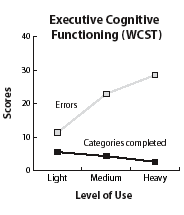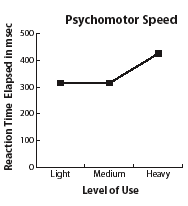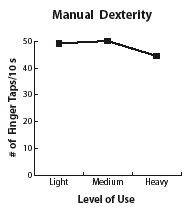
NIDA-funded scientists have found that cognitive impairments resulting from smoking marijuana can last up to at least 28 days after an individual last smoked the drug. The more a person had smoked prior to abstinence, the more profound this impairment, with marijuana smokers with lower IQs faring worse than their higher IQ peers, even if the latter had routinely smoked more of the drug.
NIDA-funded researchers Dr. Karen Bolla from the Johns Hopkins University School of Medicine in Baltimore and Dr. Jean Lud Cadet from NIDA's Intramural Research Program (IRP) admitted marijuana smokers to IRP's Clinical Inpatient Research Unit on Hopkins' Bayview campus, tested them to ensure they abstained from marijuana use throughout their 4-week stay, and gave them a battery of neurocognitive tests at the end of the study.
Twenty-two individuals participated. Their average age was 22, 86 percent were male, and all reported consuming fewer than 14 alcoholic drinks a week. The researchers estimated that the group had been smoking marijuana for an average of 4.8 years. Based on participants' reports of their current levels of marijuana use, the researchers grouped them as light, medium, or heavy smokers. "Determining an exposure index--how many joints participants smoked per week--and looking at the range of use in the study population strengthened our ability to make causal inferences," says Dr. Bolla.
Very heavy abusers smoked an average of 94 joints a week and scored worse than light abusers (average 11 joints per week) on 24 of the 35 neurocognitive tests, even after 28 days of abstinence. The measures on which the heavy abusers had comparative deficits included verbal and visual memory, executive functioning, visual perception, psychomotor speed, and manual dexterity. On some tests, quantity of marijuana use accounted for more than half the variance in test scores. "We found a dose-response relationship," says Dr. Bolla. "The more marijuana people used, the worse they performed on the tests, especially those for memory."
"We know a lot about the acute effects of marijuana use, but researchers are just now beginning to look at the long-term effects," says Dr. Jag Khalsa of NIDA's Center on AIDS and Other Medical Consequences of Drug Abuse. "This study demonstrates that marijuana smoking has chronic, dose-related effects on cognitive impairments up to 28 days after last use. But how long do these effects persist beyond that point? That's something we have to examine."
"We have shown that marijuana use is associated with persistent detrimental cognitive effects," explains Dr. Bolla. "These results are not attributable to use of other drugs, because participants were excluded for current or past history of significant use of other substances, including alcohol. Marijuana appears to be harmful when smoked in very large quantities."
The study results also suggested that some people are at higher cognitive risk from smoking marijuana than others. Cognitive performance in individuals with lower IQ scores decreased as the number of joints smoked per week increased, while those with higher IQ scores had fewer decrements even as marijuana use increased. "This finding demonstrates the concept of cognitive reserve," says Dr. Bolla. "People with higher IQs do better than those with lower IQs; the fewer cognitive reserves you have, the more impact you will see from a slight change in brain function."
The results of this study are consistent with study findings obtained by Dr. Harrison Pope, Jr., at Harvard University McLean Hospital in Belmont, Massachusetts (see "Studies Show Cognitive Impairments Linger in Heavy Marijuana Users," NIDA NOTES, Vol. 11, No. 3). Dr. Pope and his colleagues found that memory and learning problems caused by heavy marijuana smoking lasted for at least a week after use stopped, although the problems disappeared within a month. "Since marijuana has a half-life of 4 days, the neurocognitive effects seen in Dr. Pope's study after 7 days indicate that marijuana does have residual effects," says Dr. Khalsa. "Study differences in longer term effects could be explained by differences in the study population."
"In the Harvard study," Dr. Bolla notes, "participants were older, ranging from age 30 to 55; had higher IQs; were more affluent; and were more likely to be employed. Our inpatient study was conducted in the inner city with a younger, poorer population that used marijuana more heavily. Plus, Dr. Pope measured lifetime episodes of smoking marijuana, not the current number of joints smoked per week." In Dr. Bolla's study, duration of use was associated with a decrease in performance on just one neurocognitive test, which measured participants' ability to copy a complex figure.
Source
- Bolla, K.I., et al. Dose-related neurocognitive effects of marijuana use. Neurology 59(9):1337-1343, 2002.
Severity of Cognitive Deficits Varies by Level of Marijuana Use
Verbal Memory. In tests of logical memory, participants were read a paragraph and then asked questions about it immediately and again after 30 minutes. The Rey Auditory Verbal Learning Test (RAVLT) involved listening to 15 words and then repeating them either immediately (Trial 1) or after 30 minutes. The response patterns suggest difficulty with information recall, not with the acquisition or retention of information, according to the researchers.
 Heavy marijuana users scored below light users on all measures of verbal memory, although they had no problems recognizing previously learned material.
Heavy marijuana users scored below light users on all measures of verbal memory, although they had no problems recognizing previously learned material.Visual Memory. In the Symbol-Digit Paired Associate Learning test, seven flash cards featuring a symbol and a number were displayed; test subjects were then shown only the symbol and asked to supply the number that originally accompanied that symbol. In the Rey Complex Figure tests, participants were shown a complex figure and asked to draw it from memory.
 Heavy marijuana use affected visual learning and memory.
Heavy marijuana use affected visual learning and memory.Executive Cognitive Functioning. In the Wisconsin Card Sorting Test (WCST), participants are asked to sort cards by three different concepts that the tester changes. This exercise tests the subject's ability to switch cognitive sets based on feedback. Poor performance indicates difficulty incorporating feedback to guide and change incorrect response selection.
 Greater marijuana use was associated with lesser executive cognitive functioning.
Greater marijuana use was associated with lesser executive cognitive functioning.Psychomotor Speed. Participants were given the California Computerized Assessment Package (CALCAP) to measure their psychomotor speed. In this test, they were asked to hit a button when they saw a light flash. Reaction time measured the milliseconds that elapsed between the light flashing and the participant hitting the button.
 Heavy marijuana users showed slower reaction times on a test of simple reaction time.
Heavy marijuana users showed slower reaction times on a test of simple reaction time.Manual Dexterity. For this test, participants were asked to tap a finger on their left hand. Manual dexterity was determined by the number of taps made in 10 seconds.
 Heavy marijuana use was associated with lower performance on manual dexterity measures.
Heavy marijuana use was associated with lower performance on manual dexterity measures.